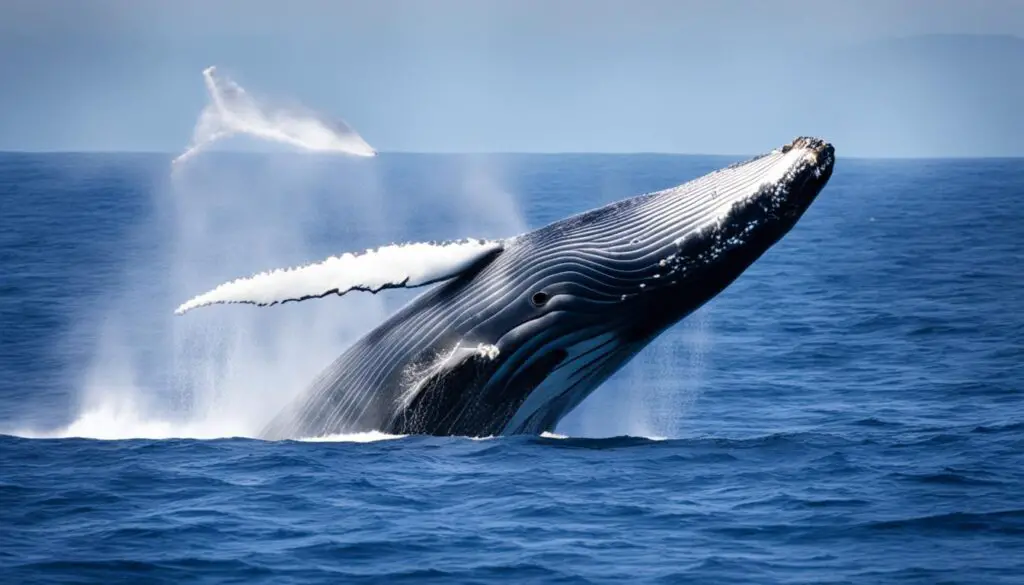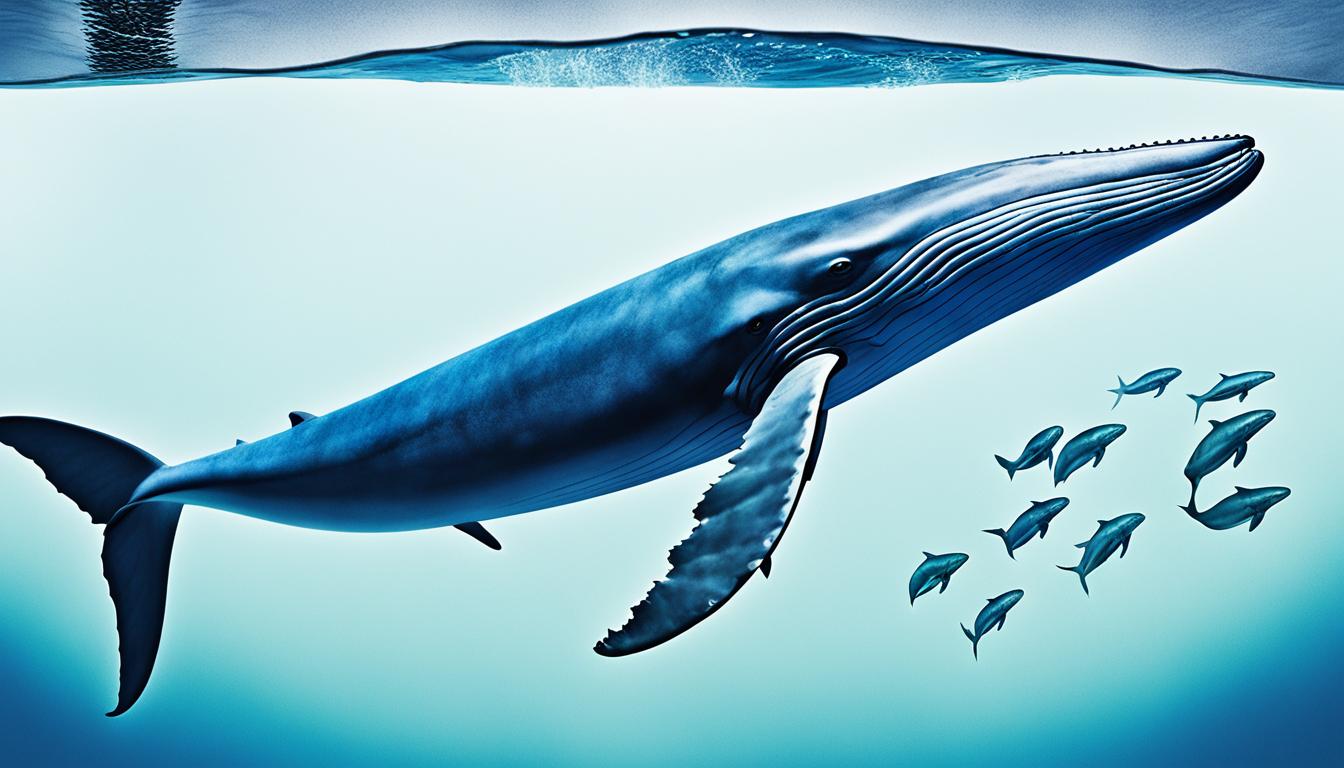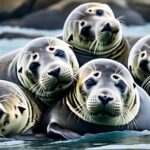Blue whales are the biggest mammals on Earth. They mainly eat krill, which are tiny shrimp-like crustaceans. Knowing what blue whales eat helps us understand their role in the ocean.
These huge creatures can be over 100 feet long and weigh up to 180 tons. They need to eat a lot to stay that big. Their diet shows their unique eating habits and how they survive.
A single blue whale can eat up to 16 tons of krill in a day. This shows how important their eating habits are for their survival and the ocean’s balance. We will look into their diet, how they eat, and their eating patterns throughout the year.
The Blue Whale Diet
The blue whale is the biggest animal on Earth. It eats mainly krill, a tiny but common sea creature. This diet is key to the ocean’s balance.
Krill: The Primary Food Source
Krill, just 1-2 centimeters long, is the blue whale’s main food. In rich waters, they eat up to four tons of krill a day. They like krill because it’s found where phytoplankton grows, making more krill.
Blue whales are great hunters. They can find and eat huge amounts of krill at once.
Other Marine Prey
But krill isn’t all they eat. They also eat small fish, crustaceans, and squid. This shows how adaptable blue whales are in finding food, especially when krill is scarce.
| Food Type | Average Size | Frequency of Consumption |
|---|---|---|
| Krill | 1-6 inches | Very High |
| Small Fish | 3-12 inches | Low |
| Crustaceans | 1-6 inches | Medium |
| Squid | 4-18 inches | Occasional |
What do blue whales eat?
Blue whales play a big role in the ocean’s ecosystem. They eat a lot to support their huge size. Their eating habits show how important they are to the sea.
Daily Consumption and Feeding Habits
A blue whale eats about 40 million krill every day. That’s almost 8,000 pounds of food. They dive deep, around 300 feet, at night to catch krill. This helps them eat as much as they need during these key hours.
Impact on Marine Ecosystem
Blue whales eat a lot, which affects the ocean’s ecosystem. Their waste helps phytoplankton grow. Phytoplankton is key to the ocean’s food chain, helping krill and other sea creatures.
Blue Whale Feeding Techniques
Blue whales have fascinating ways of feeding that help them survive in the ocean. These methods show how they eat and what they need to eat to stay healthy.
Filter Feeding Explained
Blue whales use a special way to eat called filter feeding. This lets them eat a lot of krill without using a lot of energy. They open their huge mouths to let water and krill in. Then, they close their mouths and push the water out through their baleen plates, trapping the krill inside.
This method is key to their survival. It shows how blue whales have developed unique blue whale feeding habits over time.
Baleen Plates: The Filter System
Baleen plates are vital for blue whales to eat. They are long, frilly structures in the whale’s mouth. Each plate helps separate krill from water, making sure the whale gets a good meal.
This high-quality food is crucial for the whales’ health and their blue whale nutrition needs. The baleen’s role in catching small sea creatures is essential for the whales’ survival.

Blue Whale Meal Plan Throughout the Year
Learning about the blue whale’s meal plan means looking at their eating habits and how they move. They go to areas with lots of food in the summer. This helps us understand their role in nature and why we need to protect their homes.
Seasonal Feeding Patterns
Blue whales have special eating habits by season. In summer, they eat a lot of krill, which is key to their diet. They gain a lot of weight during this time as they try to eat enough. Amazingly, they eat a big part of their yearly food needs in just a few months.
Migration and Food Availability
The way blue whales move is tied to where they find food. When they go to warmer waters in winter, they focus on saving energy. Krill, their main food, depends on the ocean’s conditions. This movement helps them always find enough to eat.
Blue Whale Nutrition Needs
Understanding how blue whales eat is key to knowing how they live in the ocean. They need a lot of food to stay big and active. Their diet mainly includes krill, which is high in calories. They eat about 12% of their body weight in krill every day, which is thousands of calories.
Caloric Intake and Energy Requirements
Blue whales need a lot of calories to survive and have babies. This food helps them keep their huge bodies going and helps their babies grow strong. A good diet is important for their health and helps the blue whale population stay healthy.
Importance of High-Quality Diet
Blue whales eat food that is full of nutrients. This helps them face challenges in their environment and live in their ecosystems. By eating krill, they help keep the ocean’s food web healthy. This shows how all marine life is connected.
FAQ
What do blue whales primarily eat?
Blue whales mainly eat krill. These are tiny shrimp-like crustaceans that are crucial for their diet.
How much krill can a blue whale consume in a day?
In a day, a blue whale can eat up to 16 tons of krill. That’s about 40 million individual krill.
Do blue whales eat anything other than krill?
Yes, besides krill, blue whales may eat small fish, crustaceans, and squid. But krill is the main part of their diet.
How do blue whales feed?
Blue whales feed by filter feeding. They open their mouths to let in water and krill. Then, they expel the water through their baleen plates, trapping the krill inside.
What seasonal patterns do blue whales have in their feeding habits?
Blue whales follow seasonal feeding patterns. They move to areas with lots of nutrients in the summer. In the winter, they go to warmer waters for breeding.
What role do blue whales play in the marine ecosystem?
Blue whales help recycle nutrients in the ocean with their waste. This fertilizes the sea and supports phytoplankton growth. Phytoplankton is key for krill survival.
How do blue whales maintain their energy levels?
Blue whales need a diet full of calories to stay energized. They eat a lot of krill, up to 12% of their body weight every day.
How do blue whale feeding habits affect their reproductive success?
A diet rich in nutrients is vital for blue whales. It helps raise healthier calves and keeps their population stable.







